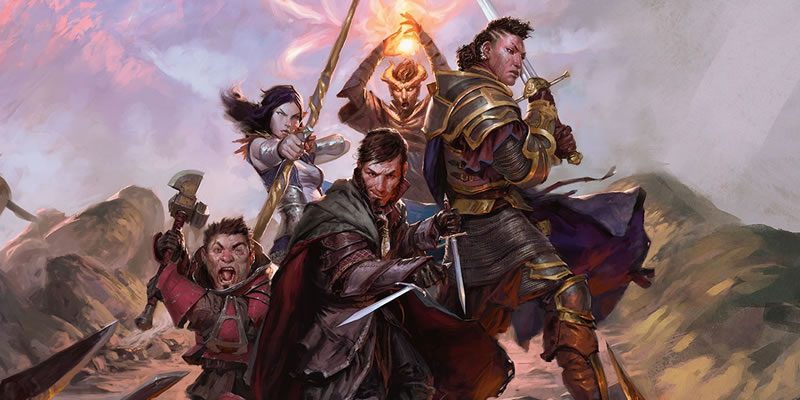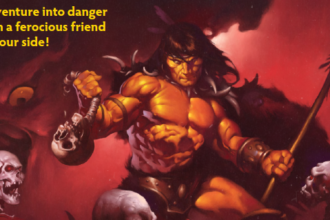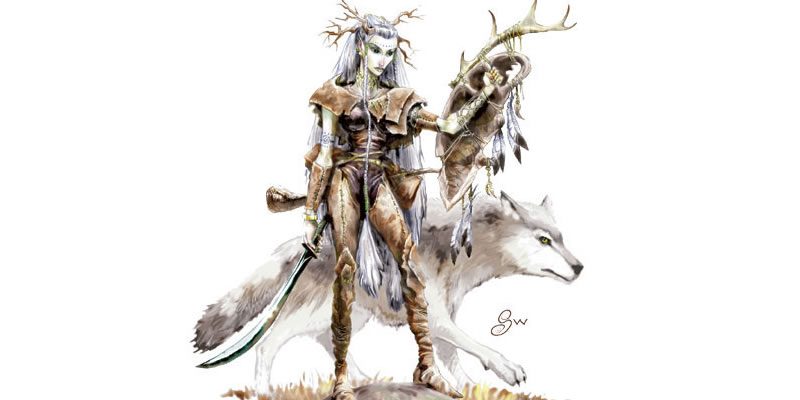Unearthed Arcana: Cleric, Druid, and Wizard Breakdown

Another UA release dropped today, with subclasses for the cleric (Twilight – not a vampire thing), druid (Wildfire – not a NERF gun), and wizard (Onomancy: divination through names). Not only am I into those concepts, the file name of the document sells the coolness on its own: “Twilight Fire Names.” Sounds like some powerful ritual magic to me!
I’m going to talk a bit about supporting-fiction inspirations for each subclass. The funny thing: from things Dan Dillon said on Twitter and in conversation, basically none of these are “right” guesses of what they were consciously emulating. The concepts have enough breadth to feel “right” even if you’re working from a different specific text.
Oh, and that tweak to feature presentation we saw two weeks ago continues here – “xth-level Subclass feature” – while also dropping the “Starting at xth level” verbiage from the beginning of every feature. I am unequivocally for this change.
The Twilight Domain
This is one we don’t see as a major presence in earlier editions of D&D – not 2e with its Spheres or 3.x/4e domains. It’s about liminal space and vigilance, a strong starting point.
- The Twilight Domain Spells lean heavily on auras and stealth. If you decide that the Archfey of your setting can have clerics (a valid choice in 2e cosmology, gradually more dubious thereafter), this is a deeply fey-friendly list.
- I had 100% forgotten that there was a spell in the Player’s Handbook called circle of power. I would be quite surprised if I had ever read it before today, except that surely I must have?
- Bonus Proficiencies grants proficiency in martial weapons and heavy armor. That’s an interesting move for a potentially sneaky subclass. It’s a guardianship thing, with a potential specific nod to the Night Watch of Westeros.
- Eyes of Night gives you very superior darkvision (no range limit), and lets you share this benefit with nearby creatures a number of times per long rest equal to your Wisdom bonus. I feel weird about the implicit arms race of “best at seeing in the dark,” here thinking of drow, Devil Sight warlocks, Shadow sorcerers, and Gloom Stalker rangers as some of the other contestants. This one doesn’t do anything about magical darkness, but I think this is the only no-range-limit darkvision we’ve seen.
- Here again, I imagine a connection to the Night Watch of Westeros – because a 60-foot darkvision range would do less than nothing from the top of the Wall.
- Vigilant Blessing lets you give one creature at a time advantage on their next initiative roll. This is nice to have and sells theme, but it’s not that big of a deal in the balance.
- Channel Divinity: Twilight Sanctuary at 2nd level lets you create a “bubble” of dim light and bolstering energy around yourself, granting 1d8 temporary hit points or cleansing charmed/frightened effects at the end of each creature’s turn in the area if you wish. (No further action cost to you.)
- Ways to purge charmed/frightened conditions aren’t super common, though calm emotions can fake it pretty well. The 30-ft radius of this effect matters a whole lot for things like crown of madness and dominate person – a hostile charmed creature might get one last chance to incapacitate you before its turn ends and you remove the condition.
- Steps of the Brave at 6th level grants you advantage on saving throws against the frightened condition (there’s scary stuff in the night, you’re good with it) and lets you fly short distances if you start in dim light or darkness. Using a darkness spell as a short-range fly spell is kind of fascinating by itself. I have no objection to a flight feature in this domain, but it does feel like a bit of a conceptual outlier.
- Divine Strike at 8th level adds 1d8 psychic damage to one melee weapon attack per round, 2d8 at 14th. Standard format is standard; psychic damage is as good a choice as anything. The other one I would have considered is radiant, for a moonlight theme.
- Midnight Shroud at 17th level lets you give several, probably 5, creatures the ability to see through magical darkness that you create. That’s very helpful even at 17th level if you’re willing to lean into it tactically, though by that level you’re seeing a lot more creatures with tremorsense, blindsight, or similar perception features.
This domain strikes me as stylish, thematic, and probably quite underpowered except for well-coordinated uses of Twilight Sanctuary. It’s often kicking out (party size)d8 temporary hit points every round for 1 minute, 2-3 times per short rest. That’s not stopping all incoming damage – 1d8 just isn’t going to get that done– but you could very reasonably hope to stop around 15 damage per character per combat. You’re shutting down charm/frighten-based encounters pretty hard. It’s hard to say if that’s enough to be the core mechanical power of the domain, especially without a scaling function. Tacking on a boost at 17th level could be a thing.
I’m surprised there aren’t more sleep- or dream-related features thrown into this. I mean, do whatever suits you with a subclass, but that’s the kind of thing one often sees in a concept that stays on the benevolent side of darkness and night themes.
The Circle of Wildfire
Fire and regrowth are natural things, part of the world’s cycles, and this is the druid for making that the center of their praxis. I go in expecting to find a druid with a big emphasis on area damaging effects, maybe some shades of the WoW boomkin – let’s see if I’m right.
- The Circle of Wildfire Spells easily slot into “we burn things but still care about animals and plants” (“mostly it’s people we have some misgivings about”).
- Summon Wildfire lets you summon a small fire elemental, expending your Wild Shape to do so. Its stats resemble the various pets from the artificer UA drafts. It has a Flame Seed ranged attack and a short-range group teleport. Summoning it and using its teleport both splash around fire damage. Its actions other than Dodge cost your bonus action, but that’s mostly fine for druids. In itself, it’s a modest boost to your damage output.
- With this and a lot of pet builds, I wish the creature had a particular function for times when your character falls unconscious, so that you can stay in the action until they take out your pet too.
- Enhanced Bond at 6th level improves your healing and fire-damage spell effects by 1d8 (per casting, not per round for things that repeat) while your wildfire elemental is active. The elemental can also be the origin point for your non-Self spells. That’s a great kicker to damage and healing, and pays off extra for area damage and healing.
- Flames of Life at 10th level lets you turn creatures that die near you into bonfires, which either damage or heal as you prefer. You choose which one when a creature touches it, so your enemies can’t readily steal the healing from you. This feature could be kicking out 10d10 + (5 * your Wisdom modifier) per long rest in healing – which makes up for a lot of spell slots you’re spending on fireball instead of healing.
- Blazing Endurance at 14th level is classic phoenix-themed stuff – “Out of the ash / I rise with my red hair / And I eat men like air.” (“Lady Lazarus,” by Sylvia Plath) – that burns nearby enemies, picks you back up, and gives you a big bucket of temporary hit points when you fall to 0 hit points and don’t die instantly.
I was all about Phoenix sorcery in concept, back when that was in a UA, and I am if anything even more about a Phoenix druid. This looks like super fun gameplay, and the theme is crystal-clear. You might not get invited to other druids’ dinner parties, though. You keep burning the pot roast!
Onomancy Tradition
I have seen so many talented designers break themselves on the rocks of trying to write a cogent, playable system for true name magic – starting with me. How do you learn someone’s true name? What are the allowable ways to conceal your own true name? Does every person have a true name? Do objects have truenames? What’s the range of Bad Stuff you can do to someone once you have it? Right out the gate, we get a sidebar establishing some cosmic rules for true names.
- Bonus Proficiencies grant you proficiency in calligrapher’s tools and in one language of your choice. Sounds good. (Though it makes me suddenly wonder why wizards, as a class, don’t automatically get proficiency in calligrapher’s tools, what with that spellbook.)
- Extract Name wins several major awards for the most unsettling feature name I have read in awhile, though its effect is not that You can force one creature to tell you its name and be charmed by you for 1 round, on a failed save; on a success, you can’t ever use this feature on that creature again. (You’ll have to use some other means, not spelled out in this document, to pursue its true name.) You get a limited number of uses of this per long rest.
- This is a great feature for making true names something you could plausibly gain and use, as opposed to “yep, if we got someone’s true name, that would be great, but that’s never happening, so forget it.”
- Notably, this reads like it wouldn’t work on creatures that can’t be charmed, such as those affected by a mind blank or Archfey warlocks with the Beguiling Defenses feature. This isn’t quite the same as the Enchanter wizard’s problems with creatures that can’t be charmed, because you could get a true name some other way – but it definitely represents a substantial hurdle.
- Fateful Naming at 2nd level (Edit: Corrected a previous error, with thanks to inestimable Lochinvar) teaches you to bend fate, in the form of the bless and bane They’re wizard spells that you know and always have prepared, for free. (Bless: still one of the best spells in the game.) Also, you don’t spend a spell slot to cast them if you utter the true name of one target at the time of casting, a number of times per day equal to your Int modifier.
- This is an awesome feature. The narrative-mechanical connection is outstanding, and the choice point around uttering a true name can be thorny in some campaigns.
- Resonant Utterance, also at 6th level, is the hard-hitting portion of what you can do to people with their true name. You learn two out of six options in this list, you can use them when you cast a spell that costs a slot, and you can do that a number of times equal to half your wizard level per day.
- The worst I’d say of this as a fundamental structure is that we’re getting into a lot of separate Int-modifier-per-long-rest currency pools, leading to higher-than-usual data-tracking burden (wizards already go very heavy on this, of course).
- Absorption gives you a pool of temporary hit points when you cast a damaging spell at a target you Name. There’s a scaling function.
- Devastation imposes disadvantage on the saving throw.
- Dissolution is a scaling damage kicker. +2d8/3d8 (10th)/4d8 (14th) force damage. Woof.
- Nullification tells you every spell currently affecting the target and lets you try to end one of them with an Int check. Holy cats, this is good – whether stripping out buffs on an enemy or purging debuffs from your friends. The one thing about this that is unclear is what happens when you use it on a spell that can only be removed with a specialized list of spells – which “specific trumps general” do you follow with this feature?
- Puppetry lets you knock a creature prone or move it 10 feet toward or away from you, no saving throw allowed. Setting up your melee friends with a prone target is never a bad way to go, but to my eyes this is the most disposable of the six.
- Sympathy lets you circumvent the requirement of “that you can see” in spells, striking through total cover or invisibility. This doesn’t come up that often, but when it does, you will feel like the baddest bitch ever.
- Nullification, and arguably Devastation and Dissolution, make me think of the Rite of Naming at the Battle of the Barrowland, in Glen Cook’s The White Rose (third book fo the Black Company series). That’s an absolutely amazing sequence.
- Others have pointed to the Kingkiller Chronicles by Patrick Rothfuss as a core inspiration. For that matter, I recall an abortive attempt at including true name magic in 5e, back in the early stages of D&D Next.
- Really, though, the triumph of this is that it is a viable way to play Ged, from Ursula K. LeGuin’s Earthsea novels. To me, this is on par with hearing that a single subclass has sufficiently captured Merlin or Gandalf.
- Inexorable Pronouncement at 10th level teaches you two more Resonants.
- Relentless Naming at 14th level lets you change any other damage type you would inflict with a spell to force or psychic, if you say the target’s name as part of casting.
This has to be one of the most compelling and stylish subclasses I’ve seen in all of 5e, full stop. I am so excited to see a meaningful effort at presenting playable true name magic – yes, you’ll fight things where your subclass features are no help, but let’s hope your DM has the good sense not to do that all the time.
I desperately want to start seeing ways for wizards to dabble in a second Tradition, for fighters to learn the tricks of other fighter archetypes, and sorcerers to temporarily infuse themselves with the power of a second sorcerous origin. Specifically, I’m playing a Diviner who would love to get in on this Onomancy act, without leaving Divination behind. Maybe there’s some sane way to write feats for this?
For the document as a whole, I have some misgivings about getting enough functionality out of the Twilight domain for it to compete with other melee-friendly domains, but I like the overall style. The Wildfire druid looks incredibly fun, as long as you’re up for managing a pet. Finally, the Onomancy wizard couldn’t be any more My Thing if it came with the opening lines of Beowulf embroidered on it. If you need someone to be objective about it, sorry, you’ll need another blogger.



